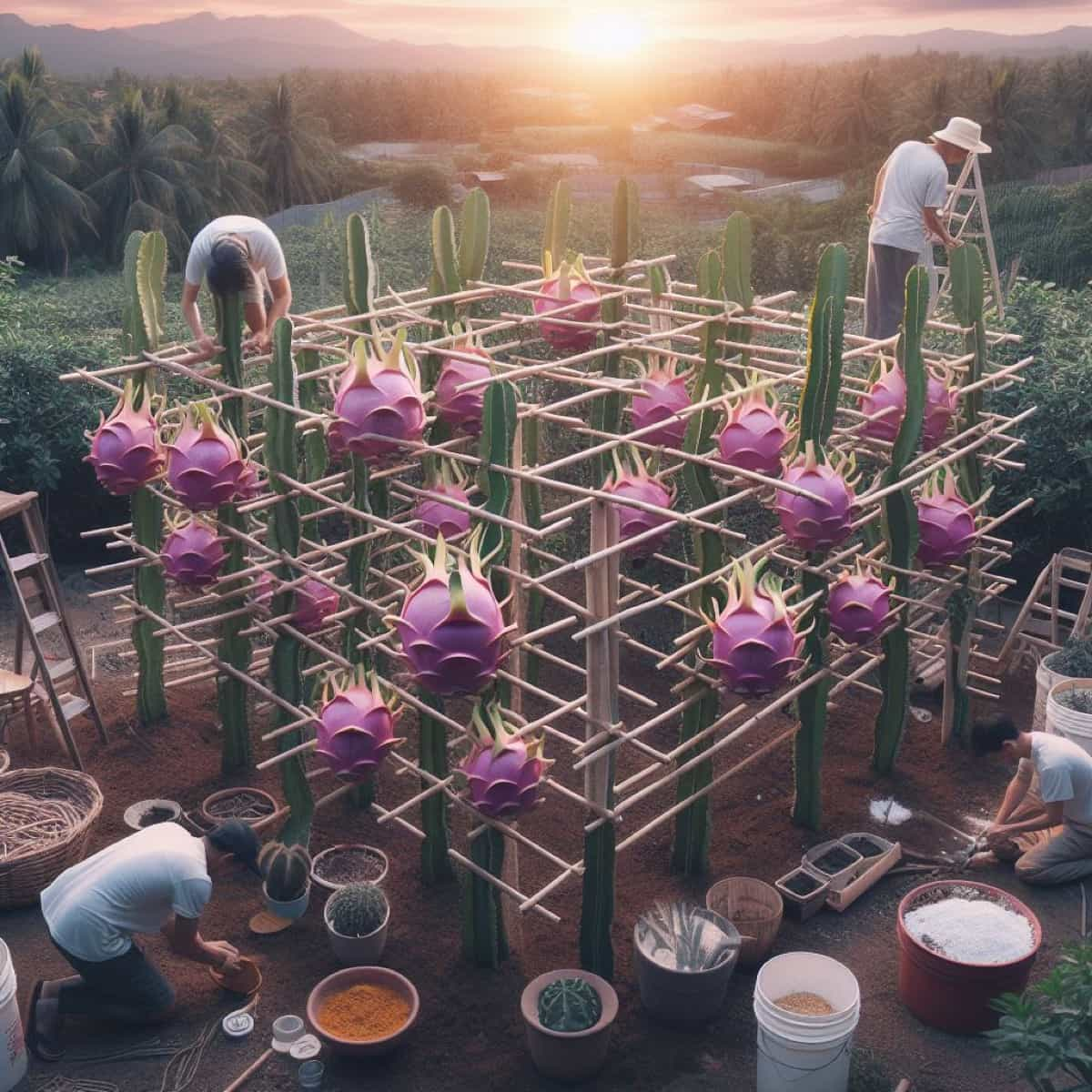Dragon fruit, a vibrant and exotic fruit, is gaining popularity not just for its taste but also for its aesthetic appeal in gardens. Building a trellis for dragon fruit is an engaging DIY project, combining elements of garden design and practical construction. Here we learn about simple steps to build a trellis for dragon fruit, from design layout to installation.

We’ll cover essential aspects such as understanding the plant’s needs, selecting the right location, choosing the best design, gathering materials, constructing the framework, installing the trellis, training the plants, and maintaining the structure.
How to Build a Trellis for Dragon Fruit
Understanding the Needs of Dragon Fruit Plants
Dragon fruit plants require specific conditions to thrive, including ample sunlight, support for climbing, and well-drained soil. Understanding these needs is crucial for a successful dragon fruit trellis design. The trellis should be situated in a location that receives enough sunlight throughout the day, as dragon fruit plants love the sun.
The structure should also be sturdy enough to support the weight of mature plants. Considering the dragon fruit trellis dimensions is important; the trellis should be tall enough to allow for easy harvesting and to enable the plant to grow freely. A balance between sunlight exposure, support, and space is key to a thriving dragon fruit plant.
Selecting the Right Location for Your Dragon Fruit Trellis
The right location is pivotal for the success of your dragon fruit trellis. Select a location abundant in sunlight, as dragon fruit plants require it for fruit production. The area should also have good air circulation and be protected from strong winds that might damage the trellis or the plants.
In case you missed it: Cost of Drip Irrigation Per Acre for Dragon Fruit: Exploring Installation Costs Along with Subsidy

Furthermore, it is imperative to confirm that the soil exhibits proper drainage to avert the occurrence of root rot. The location should also accommodate the dragon fruit trellis dimensions, allowing enough room for the trellis to stand and for you to move around it for maintenance and harvesting.
Choosing the Best Design for Your Dragon Fruit Trellis
When it comes to dragon fruit trellis design, there are several options to consider. A popular choice is the single-post design, which is simple and effective for supporting dragon fruit plants. This design involves a central post with support arms at the top, creating an umbrella-like structure. Another option is the T-shaped trellis, which provides more space for multiple plants. The optimal dragon fruit trellis design hinges on factors such as the desired plant quantity, available space, and individual preferences.
Gathering Materials for Building a Sturdy Dragon Fruit Trellis
To build a sturdy dragon fruit trellis, you need the right materials. Start by selecting durable, weather-resistant wood or metal for the posts and support arms. You’ll also need concrete for securing the posts in the ground, screws or nails for assembly, and tools like a hammer, drill, and saw. If you’re looking for a simpler option, consider a dragon fruit trellis kit, which includes pre-cut and pre-drilled components. Remember to gather protective gear such as gloves and goggles for safety during construction.
Constructing the Framework of Your Dragon Fruit Trellis
Constructing the framework of your dragon fruit trellis involves several steps. First, cut the posts and support arms to the desired dragon fruit trellis dimensions. Then, dig holes for the posts, ensuring they are deep enough for stability. Place the posts in the holes and use concrete to secure them.
Once the concrete has been set, attach the support arms to the top of the posts. If you are using a dragon fruit trellis kit, follow the instructions provided for assembly. Before advancing to the next step, it is imperative to confirm that all components are firmly affixed and that the integrity of the structure is sound.
Installing the Trellis in Your Garden or Farm
After constructing your dragon fruit trellis, the next step is installation. Carefully position the trellis in the selected location, making sure it is level and stable. If your design requires additional support, you can anchor the trellis to nearby structures or use stakes. Once the trellis is installed, check that it is firmly in place and make any necessary adjustments. A properly installed dragon fruit trellis will provide a strong foundation for your plants to climb and thrive.
In case you missed it: Best Intercrops for Dragon Fruit Plantations: Exploring Benefits of Intercropping in Dragon Fruit Orchards

Training and Supporting the Dragon Fruit Plants on the Trellis
Training and supporting the dragon fruit plants on the trellis is essential for their growth and fruit production. Start by gently tying the young plants to the trellis using soft ties or plant tape. As the plants grow, continue to guide and secure them to the structure. Be careful not to damage the stems while tying them. Frequently inspect the plant supports and make necessary adjustments to accommodate the plants’ growth. Proper training and support will ensure that your dragon fruit plants grow healthy and produce abundant fruit.
Maintaining and Caring for Your Dragon Fruit Trellis
Maintaining and caring for your dragon fruit trellis is important for the longevity of the structure and the health of the plants. Perform routine examinations of the trellis to identify any indications of wear or harm, and promptly address any necessary repairs. Keep the area around the trellis clean and free of weeds. Prune the dragon fruit plants to promote growth and fruit production. Additionally, ensure the plants are receiving adequate water and nutrients. With appropriate upkeep, your dragon fruit trellis will provide durable and aesthetically pleasing plant support for many years.
Harvesting and Pruning Techniques for Dragon Fruit Plants
The process of harvesting dragon fruit entails inspecting the fruit for color changes as a sign of ripeness, followed by the use of a sharp knife to carefully detach it from the stem. The best time to harvest is when the fruit’s skin turns color but before it overripens. Pruning is crucial for plant health and productivity.
After the fruiting season, prune the plant by cutting off dead or excess growth to encourage new fruiting branches. This procedure not only promotes plant growth but also contributes to the preservation of the plant’s dimensions and form, facilitating more convenient management on the trellis.
Troubleshooting Common Issues with Dragon Fruit Trellises
Common issues with dragon fruit trellises include structural instability, pest infestations, and inadequate support for the plants. To address these, regularly inspect the trellis for any signs of weakness or damage and reinforce or repair as needed. Pest control can be managed through regular monitoring and the use of natural or chemical repellents as necessary. Ensure that the trellis provides sufficient support for the growing plants, and adjust or add more support arms if the plants seem to be straining the structure.
In case you missed it: Pruning and Training Methods for Dragon Fruit Plants: How and When to Do?

Conclusion
Building and maintaining a trellis for dragon fruit is a rewarding endeavor that enhances the productivity and health of the plants. With the right design, materials, and care, your dragon fruit trellis will not only support the growth of these exotic plants but also add a unique aesthetic to your garden. Remember, regular maintenance and proper harvesting and pruning techniques are key to a thriving dragon fruit garden.
- Feed Your Flock for Less: Top 10 Tips to Save on Chicken Feed
- Ultimate Guide to Ossabaw Island Hog: Breeding, Raising, Diet, and Care
- Hatching Answers: The Top 10 Reasons Your Chickens Aren’t Laying Eggs
- Eggs and Economics: Breaking Down the Cost of Raising Backyard Chickens
- Defend Your Greens: Proven Methods to Keep Iguanas Out of Your Garden
- Ultimate Guide to Cinnamon Queen Chicken: A Comprehensive Guide for Beginners
- Ultimate Guide to California Tan Chicken: Breeding, Raising, Diet, Egg-Production and Care
- Ultimate Guide to Marsh Daisy Chicken: Breeding, Raising, Diet, and Care
- 10 Types of Chicken Farming Businesses You Can Start for Profits